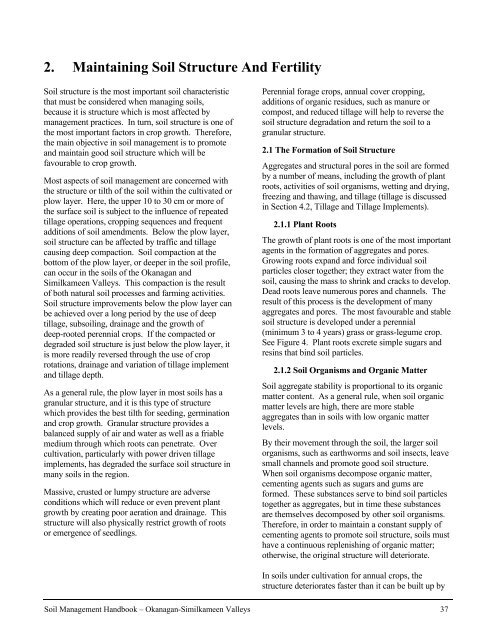Soil Management Handbook - Ministry of Agriculture and Lands
Soil Management Handbook - Ministry of Agriculture and Lands
Soil Management Handbook - Ministry of Agriculture and Lands
Create successful ePaper yourself
Turn your PDF publications into a flip-book with our unique Google optimized e-Paper software.
2. Maintaining <strong>Soil</strong> Structure And Fertility<br />
<strong>Soil</strong> structure is the most important soil characteristic<br />
that must be considered when managing soils,<br />
because it is structure which is most affected by<br />
management practices. In turn, soil structure is one <strong>of</strong><br />
the most important factors in crop growth. Therefore,<br />
the main objective in soil management is to promote<br />
<strong>and</strong> maintain good soil structure which will be<br />
favourable to crop growth.<br />
Most aspects <strong>of</strong> soil management are concerned with<br />
the structure or tilth <strong>of</strong> the soil within the cultivated or<br />
plow layer. Here, the upper 10 to 30 cm or more <strong>of</strong><br />
the surface soil is subject to the influence <strong>of</strong> repeated<br />
tillage operations, cropping sequences <strong>and</strong> frequent<br />
additions <strong>of</strong> soil amendments. Below the plow layer,<br />
soil structure can be affected by traffic <strong>and</strong> tillage<br />
causing deep compaction. <strong>Soil</strong> compaction at the<br />
bottom <strong>of</strong> the plow layer, or deeper in the soil pr<strong>of</strong>ile,<br />
can occur in the soils <strong>of</strong> the Okanagan <strong>and</strong><br />
Similkameen Valleys. This compaction is the result<br />
<strong>of</strong> both natural soil processes <strong>and</strong> farming activities.<br />
<strong>Soil</strong> structure improvements below the plow layer can<br />
be achieved over a long period by the use <strong>of</strong> deep<br />
tillage, subsoiling, drainage <strong>and</strong> the growth <strong>of</strong><br />
deep-rooted perennial crops. If the compacted or<br />
degraded soil structure is just below the plow layer, it<br />
is more readily reversed through the use <strong>of</strong> crop<br />
rotations, drainage <strong>and</strong> variation <strong>of</strong> tillage implement<br />
<strong>and</strong> tillage depth.<br />
As a general rule, the plow layer in most soils has a<br />
granular structure, <strong>and</strong> it is this type <strong>of</strong> structure<br />
which provides the best tilth for seeding, germination<br />
<strong>and</strong> crop growth. Granular structure provides a<br />
balanced supply <strong>of</strong> air <strong>and</strong> water as well as a friable<br />
medium through which roots can penetrate. Over<br />
cultivation, particularly with power driven tillage<br />
implements, has degraded the surface soil structure in<br />
many soils in the region.<br />
Massive, crusted or lumpy structure are adverse<br />
conditions which will reduce or even prevent plant<br />
growth by creating poor aeration <strong>and</strong> drainage. This<br />
structure will also physically restrict growth <strong>of</strong> roots<br />
or emergence <strong>of</strong> seedlings.<br />
Perennial forage crops, annual cover cropping,<br />
additions <strong>of</strong> organic residues, such as manure or<br />
compost, <strong>and</strong> reduced tillage will help to reverse the<br />
soil structure degradation <strong>and</strong> return the soil to a<br />
granular structure.<br />
2.1 The Formation <strong>of</strong> <strong>Soil</strong> Structure<br />
Aggregates <strong>and</strong> structural pores in the soil are formed<br />
by a number <strong>of</strong> means, including the growth <strong>of</strong> plant<br />
roots, activities <strong>of</strong> soil organisms, wetting <strong>and</strong> drying,<br />
freezing <strong>and</strong> thawing, <strong>and</strong> tillage (tillage is discussed<br />
in Section 4.2, Tillage <strong>and</strong> Tillage Implements).<br />
2.1.1 Plant Roots<br />
The growth <strong>of</strong> plant roots is one <strong>of</strong> the most important<br />
agents in the formation <strong>of</strong> aggregates <strong>and</strong> pores.<br />
Growing roots exp<strong>and</strong> <strong>and</strong> force individual soil<br />
particles closer together; they extract water from the<br />
soil, causing the mass to shrink <strong>and</strong> cracks to develop.<br />
Dead roots leave numerous pores <strong>and</strong> channels. The<br />
result <strong>of</strong> this process is the development <strong>of</strong> many<br />
aggregates <strong>and</strong> pores. The most favourable <strong>and</strong> stable<br />
soil structure is developed under a perennial<br />
(minimum 3 to 4 years) grass or grass-legume crop.<br />
See Figure 4. Plant roots excrete simple sugars <strong>and</strong><br />
resins that bind soil particles.<br />
2.1.2 <strong>Soil</strong> Organisms <strong>and</strong> Organic Matter<br />
<strong>Soil</strong> aggregate stability is proportional to its organic<br />
matter content. As a general rule, when soil organic<br />
matter levels are high, there are more stable<br />
aggregates than in soils with low organic matter<br />
levels.<br />
By their movement through the soil, the larger soil<br />
organisms, such as earthworms <strong>and</strong> soil insects, leave<br />
small channels <strong>and</strong> promote good soil structure.<br />
When soil organisms decompose organic matter,<br />
cementing agents such as sugars <strong>and</strong> gums are<br />
formed. These substances serve to bind soil particles<br />
together as aggregates, but in time these substances<br />
are themselves decomposed by other soil organisms.<br />
Therefore, in order to maintain a constant supply <strong>of</strong><br />
cementing agents to promote soil structure, soils must<br />
have a continuous replenishing <strong>of</strong> organic matter;<br />
otherwise, the original structure will deteriorate.<br />
In soils under cultivation for annual crops, the<br />
structure deteriorates faster than it can be built up by<br />
<strong>Soil</strong> <strong>Management</strong> <strong>H<strong>and</strong>book</strong> – Okanagan-Similkameen Valleys 37
















